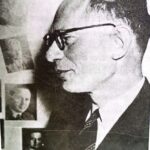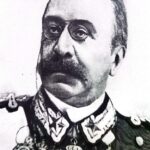MWENE PUTU KASONGO
- 7 Min Read
Mwene Putu Kasongo (who flourished in about the mid-17th century), a Lunda from western Shaba, subjected the Yaka people living along the Kwango River, southwest of modern Kikwit.
Kasongo’s activities among the Yaka were only part of a larger 16th and 17th-century Lunda pattern of conquest. Lunda expansion started with Kinguri, who, in protest against the marriage of his sister Ruwej a Nkond, to the Luba interloper Chibind Yirung, left Musumba, the Lunda capital (located 240 km, or 150 mi, north of modern Dilolo). Kinguri migrated to the southwest where he hoped to find a state to use as a base to destroy the Lunda kingdom of Musumba.
Kinguri and his men went as far as Luanda, on the Atlantic coast, where they put themselves at the service of the Portuguese. Some of his men later left the coast and moved, under the leadership of one Kulanjinga, back towards the east. They settled on the east bank of the Lui River, a tributary of the Kwango.

It was the men of this group of emigrants who later built the famous state of Kasanje on the Kwango River in Angola. This state subsequently played a determining role in the trade relations of the Portuguese African zone by serving as an intermediary or broker state between the coastal regions and the hinterland.
According to certain traditions, it was with the aim of finding their uncle Kinguri that Kasongo and his elder brother Lukundo Sango left Musumba and journeyed toward the west. On their way, the two brothers and their men had to fight hostile people who wanted to block their progress.
The fierce opposition came from the Suku and the Holo, located about 350 km (200 mi) southwest of modern Kikwit. After indecisive but bloody battles in the region of Tungula Falls and along the right bank of the Wamba River, the emigrants concluded they could not go any further without additional support from Musumba.
Kasongo, therefore, left his elder brother Lukundo, the titular leader of the expedition, on the banks of the Wamba, and went back to the Lunda capital for reinforcements. But when he returned, leading a strong army of Lunda warriors, Kasongo did not go back to his elder brother. Instead, he traveled towards the northwest, probably hoping to avoid control from Musumba’s control, and to build his kingdom.
Some Lunda traditions from the Kwango-Kwilu area claim that Kasongo left Musumba at the same time as Mai Munene and then he, together with Kisanda Kameshi and Mukelenge Mutombo, participated in Mai Munene’s expedition. After conquering the region between the Tshikapa and Kasai rivers, Mai Munene settled at the confluence of the two rivers and organised the Lunda state of Mai Munene.
Kisanda Kameshi went to the region of the upper Lovua, where he founded several chiefdoms, and appointed his brothers and some of his close relatives as chiefs. He himself moved towards Luajimu where he built the Lunda state of Kahungula, situated 100 km (60 mi) south of Mai Munene. His people adopted the name Lunda Amukundo, and he himself took the title Kahungula (meaning one who removes obstacles from his path).
Mukelenge Mutombo crossed the Lova to conquer the region between the Lutshiko and Loange rivers, where Pende people had just settled. With help from the Pende, he founded a Lunda chiefdom. He himself took the title Mwatha Kombana, which also became the name of his polity, which was located about 160 km (100 mi) southeast of what is now Kikwit.
As for Kasongo, he continued westward, crossed the upper Kwilu River, and established several Lunda settlements. After staying there for a long time, he pushed on towards the west, reaching the Kwenge River. According to the traditions of the Lunda of Kwango, Kasongo and his men had difficulty crossing this river on account of its width, its swampy banks, and the many crocodiles. Traveling for many days along the right bank in search of a passage, they arrived at the Kwenge’s five falls. Because it was the dry season, the river was low and they were able to build a bridge with stones. Their crossing, however, was marred by one painful incident, Mwaku, Kasongo’s young brother, died in the falls. The Lunda of Kwango still have a vivid memory of this crossing. The place or the ford where Kasongo forded the Kwenge is still remembered as the “Kasongo Lunda passage.”
Settling several Lunda families in the region between the Kwilu and the Kwenge, Kasongo charged them to occupy the conquered land, to make the inhabitants recognise his authority, and to pay tax to him. One of these Lunda families that of Mwene Kalunga, was active in contributing towards Lunda expansion in that area.
After crossing the Kwenge, Kasongo and his men settled temporarily west of the river at a place called Nzofu Lukunda, in the region where the Kwenge and its tributaries, the Tendwala and the Wovo, flow. With Nzofu as their base of operations, Kasongo and his men raided the regions of the upper Kwenge for several years.
In his effort to settle as far from original Lunda homeland as possible, Kasongo left the Kwenge and, with some of his followers, went further west. Reaching the Kwango River, where the Tufu and the Yonso flow, he settled on the right bank of the Kwango at the place now called Kasongo Lunda (located 200 km or 120 mi southwest of Kikwit).
Once settled, he conquered the Yaka people, who had occupied the land for a long time. After the Yaka had been subjugated, Kasongo modeled their administration on the model of the Lunda state of Musumba, with a decidedly hierarchical power system, and succession through the male line.
Having learned, as soon as he arrived in Yaka land, that the area west of the Kwango belonged to Mwene Putu (the King of Portugal). Kasongo decided to take Yamu Mwene Lunda Putu Kasongo as his title—a title which his successors still bear. They are, however, often called Kiamfu, which is a deformation of Yamwu, or else Kasongo Landa, or simply Mwene Putu. Kasongo’s arrival on the Kwango and his subsequent conquest of the Yaka probably took place soon after 1650.
Traditions of the Lunda and of other people of the Kwango-Kwilu, region describe Kasongo as a great conqueror, a man of exceptional courage, and a great political organiser. The Yaka state, which he built by introducing socio-political structures from his homeland, soon became the most powerful and extensive of all the Kwango-Kwilu polities. Essentially a military state, by the 18th century it covered much of the territory from Kwango to Lutshiko.
A western counterpart of the kingdom of Kazembe in the eastern section of the Lunda empire, Kasongo’s state played a determining role in the political and economic relations of Kwango-Kwilu regions. On the political level, the Yamu Mwene Putu subjected the people of these areas, making them his vassals and obliging them to pay tribute. This Lunda-Yaka hegemony was imposed by arms. On the commercial level, Yaka country came to serve as an intermediary between the merchants from the coast and traders from the hinterland. The Yaka jealously controlled the trade route which, from the coast (Ambriz), passed through the capital of the Kiamfu, then through the territory of Mwene Kongo, chief of the Suku, before it reached the capital of Mwatha Kombana, the Lunda chief of Lutshiko.
During the 17th and 18th centuries, slaves and ivory were the main commercial products in Central Africa. In Yaka country, the Mwene Putu (the title refers to all the successive office-holders) maintained a monopoly on these products. He also made certain never to allow the Pombeiros (Angolan merchants) to cross the Kwango River. In order to ensure supplies for the slave trade with the Atlantic coast, he started acquiring and selling men in his own kingdom. Later, when the trade increased, the Mwene Putu raided his neighbours, thus causing great damage to Kwango-Kwilu society. Faced with incessant slave raids by Yaka warriors under their Kiamfu, many Suku, Mbala, Pende, Hungaan, and Mbuun people fled from the Upper Kwango to seek refuge in the northern and eastern regions. These migrations explain, to a large extent, the dense concentration of people in the mid-Kwango and Kwilu areas.
SIKITELE GIZE a SUMBULA




